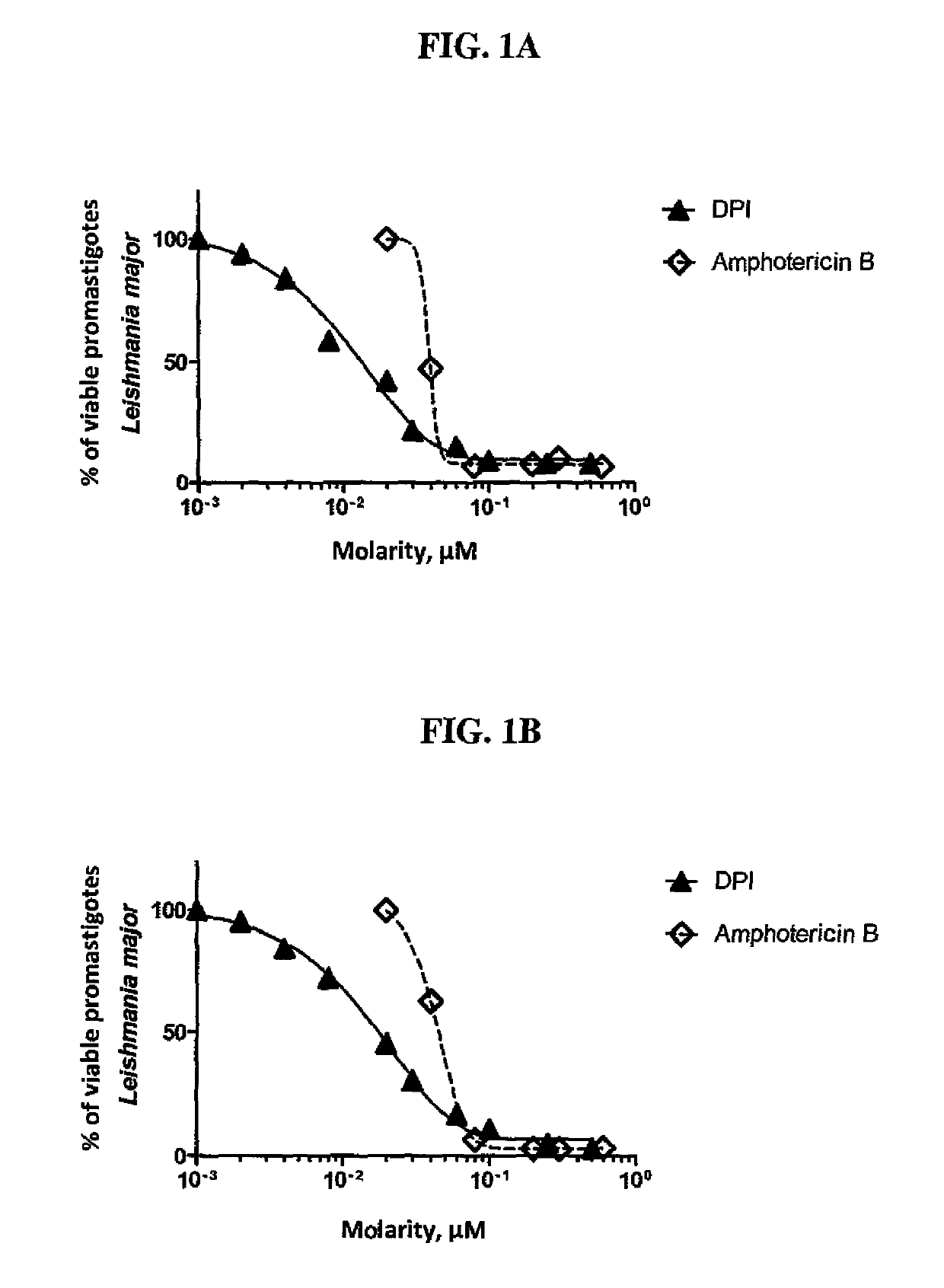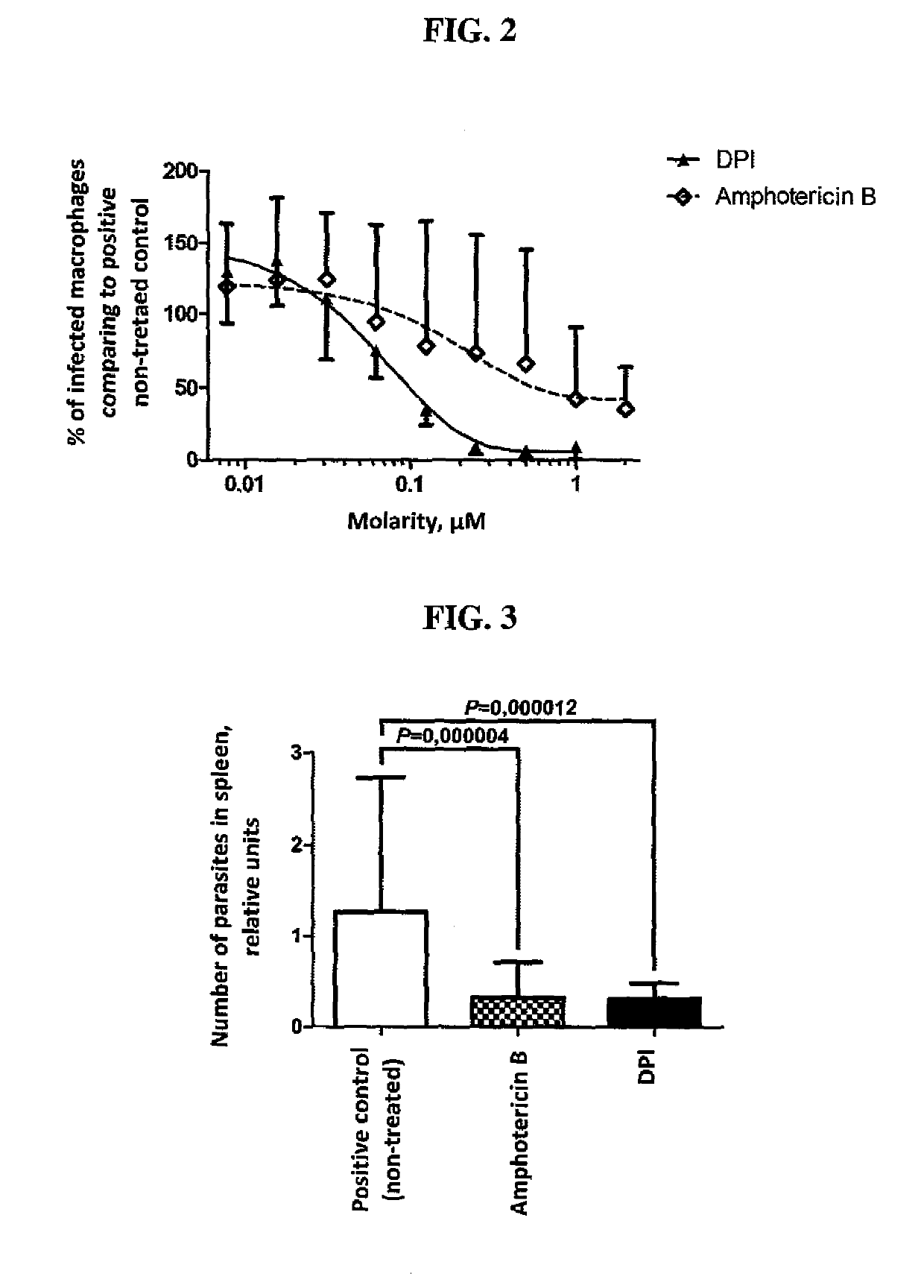Pharmaceutical composition consisting of diphenyleneiodonium for treating diseases caused by the parasites belonging to the family trypanosomatidae
a technology of trypanosomatidae and diphenyleneiodonium, which is applied in the field of diphenyleneiodonium, can solve the problems of hiv becoming a serious health problem, underreporting can have immense consequences for blood banks, and many undesirable side effects of drugs in us
- Summary
- Abstract
- Description
- Claims
- Application Information
AI Technical Summary
Benefits of technology
Problems solved by technology
Method used
Image
Examples
example 1
[0038]DPI was identified when testing the library of 2448 chemical compounds comprising “Library of Pharmacologically Active Compounds” (LOPAC1280, Sigma-Aldrich), “Prestwick Chemical Library” (Illkirch, France) and “NIH Clinical Collection” (NIH, USA). The compounds were reformatted into 384-well polypropylene plates (Corning, cat. No. 3657) at a final concentration of 1 μM in DMSO and used to screen the growth inhibition of the parasite Leishmania major.
[0039]Primary screening resulted in the finding that DPI is a potent inhibitor of the growth of Leishmania major. Therefore DPI, in the form of diphenyleneiodonium chloride, was further tested in in vitro experiments (Sigma, St. Louis, Mo., cat. No. D2926) and in vivo experiments (Sigma, St. Louis, Mo., cat. No. D2926, or AG Scientific, San Diego, Calif., cat. No. D-1011), as will be described in the following examples.
example 2
Cytostatic Effect DPI on Leishmania major in Promastigote Form (FIG. 1A, 1B)
[0040]Antiparasitic activity in culture of promastigotes (insect form) was measured using a standard microdiluting method, determining the minimum inhibitory concentration (MIC) of the test sample, which leads to inhibition of parasite growth.
[0041]Leishmania major LV 561 (MHOM / IL / 67 / LRC-L137 JERICHO II) was stored in the overlay of 10% dimethylsulfoxide in liquid nitrogen as subculture 0. Stored samples were thawed and the parasites were cultured for 7 days at 23° C. in a biphasic medium SNB-9 (saline-neopeptone-blood-9) [Grekov et al. 2011]. Solid phase and SNB-9 overlay were prepared from the following ingredients: Bacto™ Agar (Becton, Dickinson and Company, Franklin Lakes, N.J., cat. No. 214010), Bacto™ Neopeptone (Becton, Dickinson and Company, Franklin Lakes, N.J., cat. No. 211681), NaCl and defibrinated rabbit blood (Bioveta, a.s., Ivanovice na Hané, Czech Republic). The overlay solution was supplemen...
example 3
Effect of DPI In Vivo (FIG. 3)
[0052]Female BALB / c mice (8-11 weeks old) were randomly divided into four experimental groups of 8-9 animals: 1) non-infected control; 2) the infected untreated control; 3) administration of 2.5 mg / kg / day (MKD) amphotericin B; 4) administration of 0.5 MKD DPI. Promastigotes L. major (10×106) of the 7-day subculture 2 in 50 μl sterile saline (PBS) were subcutaneously inoculated to the root of mouse's tail. Non-infected control mice were inoculated with sterile saline. Application of standard drug (amphotericin B) and test substance (DPI) began the second week after infection when the majority of mice had developed a swelling at the site of parasite injection. During the following 28 days, Group 3 was treated daily by intraperitoneal injection of standard drug amphotericin B, and group 4 by injection of DPI in 20% DMSO in PBS, and groups 1 and 2 by an equal volume of 20% DMSO in PBS. Size of skin lesion was measured weekly using caliper. Mice were sacrifi...
PUM
| Property | Measurement | Unit |
|---|---|---|
| parasite resistance | aaaaa | aaaaa |
| transmission | aaaaa | aaaaa |
| concentration | aaaaa | aaaaa |
Abstract
Description
Claims
Application Information
 Login to View More
Login to View More - R&D
- Intellectual Property
- Life Sciences
- Materials
- Tech Scout
- Unparalleled Data Quality
- Higher Quality Content
- 60% Fewer Hallucinations
Browse by: Latest US Patents, China's latest patents, Technical Efficacy Thesaurus, Application Domain, Technology Topic, Popular Technical Reports.
© 2025 PatSnap. All rights reserved.Legal|Privacy policy|Modern Slavery Act Transparency Statement|Sitemap|About US| Contact US: help@patsnap.com



